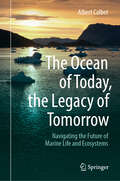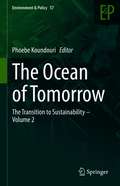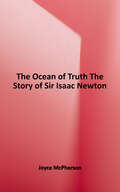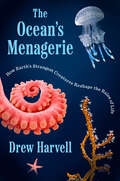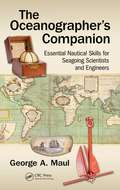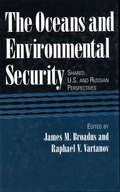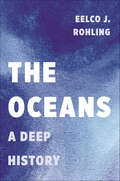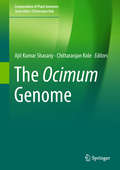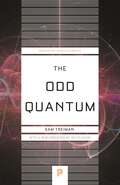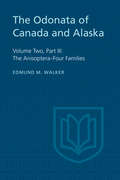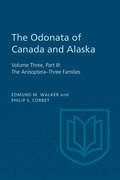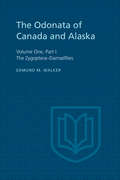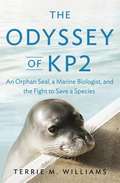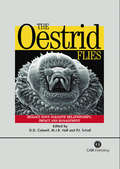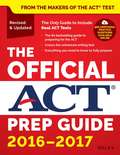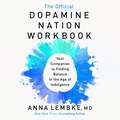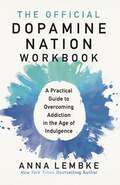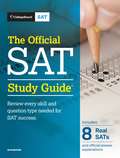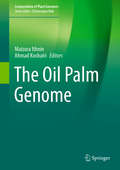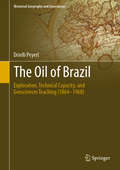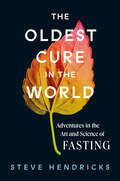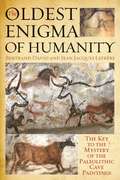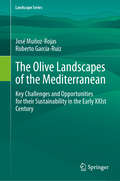- Table View
- List View
The Ocean of Today, the Legacy of Tomorrow: Navigating the Future of Marine Life and Ecosystems
by Albert CalbetThe Ocean of Today, The Legacy of Tomorrow takes you on an eye-opening journey through the intricate, fragile, and vital marine environments that sustain life on Earth. This comprehensive exploration uncovers the far-reaching impacts of climate change, overfishing, pollution, and habitat destruction on marine biodiversity. With insights into the latest scientific advancements, technological innovations, and conservation strategies, the book delves into the critical choices humanity faces in safeguarding the ocean&’s future. Engaging, informative, and forward-thinking, it challenges readers to rethink our relationship with the ocean and highlights the urgent need for sustainable action to protect this indispensable resource.
The Ocean of Tomorrow: The Transition to Sustainability – Volume 2 (Environment & Policy #57)
by Phoebe KoundouriAs a response to the climate crisis and its effect on marine ecosystems and coastal populations, this book proposes concrete science driven solutions at establishing transformation pathways towards Sustainable Blue Growth, that are supported by technically and socially innovative innovations. This book proposes investment options and management solutions that have the potential of making our seas and oceans resilient to crises- climate, financial, health- by laying the foundations for a green/blue, circular economy that is anchored in science driven solutions and geared toward public well-being. Now is the time to usher in systemic economic change and the good news is that we have our blueprint: it’s the combination of UN Agenda 2030 (17 SDG) and European Commission’s European Green Deal! There is no doubt that the Earth’s survival will depend on the protection and sustainable management of our seas and oceans and the resources they provide. This is recognized by the Joint Communication on International Ocean Governance, which is an integral part of the EU’s response to the United Nations’ 2030 Agenda for Sustainable Development, and in particular to the targets set out by Sustainable Development Goal 14 (SDG 14) to “conserve and sustainably use the oceans, seas and marine resources”. The analytical framework and science-driven concrete management solutions proposed in this book can accelerate the transition to a sustainable management of our seas and oceans, by turning the current challenges into opportunities for sustainable economic growth which is both environmentally resilient and leaves no one behind.
The Ocean of Truth: The Story of Sir Isaac Newton
by Joyce McPhersonSir Isaac Newton is one of history's most renowned scientists. He independently developed the mathematical technique known as Calculus, wrote a treatise on the properties of light and color that is still consulted by scientists, and worked out the mathematical details of the law of gravity. What is less well known is the depth of his Christian faith and the amount of writing, speaking, and research he devoted to defenses of the tenets of Biblical belief. This book makes Newton come alive for readers. From the detailed account of the events that led to his conversion, his Christian faith plays a central role in this biography, as it did in his life.
The Ocean's Menagerie: How Earth's Strangest Creatures Reshape the Rules of Life
by Drew HarvellAn elegantly written exploration of the cutting edge science of the strangest and most remarkable creatures on our planet by a leading marine biologistHundred-year-old giant clams, coral kingdoms that rival human cities, and jellyfish that glow in the dark: ocean invertebrates are among the oldest and most diverse organisms on earth, seeming to bend the &“rules&” of land-based biology. Although sometimes unseen in the deep, the spineless creatures contain 600 million years of adaptation to problems of disease, energy consumption, nutrition, and defense. In The Ocean&’s Menagerie, world-renowned marine ecologist Dr. Drew Harvell takes us diving from Hawaii to the Salish Sea, from St. Croix to Indonesia, to uncover the incredible underwater &“superpowers&” of spineless creatures: we meet corals many times stronger than steel or concrete, sponges who create potent chemical compounds to fight off disease, and sea stars that garden the coastlines, keeping all the other nearby species in balance. As our planet changes fast, the biomedical, engineering, and energy innovations of these wonderous creatures inspire ever more important solutions to our own survival. The Ocean&’s Menagerie is a tale of biological marvels, a story of a woman&’s passionate connection to an adventurous career in science, and a call to arms to protect the world&’s most ancient ecosystems.
The Oceanographer's Companion: Essential Nautical Skills for Seagoing Scientists and Engineers
by George MaulScientists and engineers embarking on their first voyage for oceanographic or meteorological research are often unprepared for the experience. Going to sea involves learning a new language – that of the seaman. This is necessary for clear communications, for the safety and well-being of the members of the scientific party and the ship’s crew. The Oceanographer’s Companion is intended to familiarize a student with the basics of navigation, seamanship, marine engineering, communications, safety-of-life-at-sea, shiphandling, knots and splices, first aid, and so much more. The book will have a very practical feel with lots of examples.
The Oceans and Environmental Security: Shared U.S. And Russian Perspectives
by Raphael V. Vartanov Suzanne M. Demisch Artemy A. Saguirian Tom Tietenburg James Broadus Matthew J. LamourieThe concept of environmental security, drawing on the widely understood notion of international strategic interdependence (in facing, for example, threats of nuclear war or economic collapse) is gaining currency as a way of thinking about international environmental management.In 1989, the Institute for World Economy and International Relations of the Russian Academy of Sciences and the Marine Policy Center of Woods Hole Oceanographic Institution instituted a joint project to examine environmental security as it applies to the world's oceans. The Oceans and Environmental Security is a unified expression of their findings.The oceans, as global commons, are of central importance to issues of international environmental security. Critical problems are those that are likely to destabilize normal relations between nations and provoke international countermeasures. As such, the book focuses on seven specific concerns: land-based marine pollution North Pacific fisheries depletion hazardous materials transport nuclear contamination the Arctic Ocean the Southern Ocean and Antarctica the Law of the Sea
The Oceans: A Deep History
by Eelco J. RohlingThe 4.4-billion-year history of the oceans and their role in Earth's climate systemIt has often been said that we know more about the moon than we do about our own oceans. In fact, we know a great deal more about the oceans than many people realize. Scientists know that our actions today are shaping the oceans and climate of tomorrow—and that if we continue to act recklessly, the consequences will be dire. In this timely and accessible book, Eelco Rohling traces the 4.4 billion-year history of Earth’s oceans while also shedding light on the critical role they play in our planet’s climate system.Beginning with the formation of primeval Earth and the earliest appearance of oceans, Rohling takes readers on a journey through prehistory to the present age, vividly describing the major events in the ocean’s evolution—from snowball and greenhouse Earth to the end-Permian mass extinction, the breakup of the Pangaea supercontinent, and the changing climate of today. Along the way, he explores the close interrelationships of the oceans, climate, solid Earth processes, and life, using the context of Earth and ocean history to provide perspective on humankind’s impacts on the health and habitability of our planet—and on what the future may hold for us.An invaluable introduction to the cutting-edge science of paleoceanography, The Oceans enables you to make your own informed opinions about the environmental challenges we face as a result of humanity’s unrelenting drive to exploit the world ocean and its vital resources.
The Ocimum Genome (Compendium of Plant Genomes)
by Chittaranjan Kole Ajit Kumar ShasanyThis book provides an overview of the Ocimum genus from its genetic diversity to genome sequences, metabolites and their therapeutic utilities. Tulasi, Ocimum tenuiflorum, as a member of the family Lamiaceae, is a sacred plant in India. The plants of this genus Ocimum are collectively referred to as Basil and holy basil is worshipped in the Hindu religion. Basils are reservoirs of diverse terpenoids, phenylpropanoids and flavonoids, in addition to commercially important aromatic essential oils. In 2016, two working groups in India published the genome sequence in two different genotypes of Ocimum tenuiflorum. To help the readers understand the complexities of the genus and different chemotypes, this book accumulates all the available information on this medicinal plant including the genome. The complete knowledge may enable researchers to generate specific chemotypes in basil either through conventional breeding or development of transgenic lines. It also makes it possible to investigate the medicinal nature of holy basil compared to different species of the same genus.
The Octopus Scientists (Scientists in the Field Series)
by Sy Montgomery Keith EllenbogenWith three hearts and blue blood, its gelatinous body unconstrained by jointed limbs or gravity, the octopus seems to be an alien, an inhabitant of another world. It's baggy, boneless body sprouts eight arms covered with thousands of suckers--suckers that can taste as well as feel. The octopus also has the powers of a superhero: it can shape-shift, change color, squirt ink, pour itself through the tiniest of openings, or jet away through the sea faster than a swimmer can follow. But most intriguing of all, octopuses--classed as mollusks, like clams--are remarkably intelligent with quirky personalities. This book, an inquiry into the mind of an intelligent invertebrate, is also a foray into our own unexplored planet. These thinking, feeling creatures can help readers experience and understand our world (and perhaps even life itself) in a new way.
The Odd Quantum (Princeton Science Library #141)
by Sam TreimanAn acclaimed physicist’s accessible yet rigorous introduction to quantum mechanics for nonspecialistsThis is a rare and much-needed book: a concise but comprehensive account of quantum mechanics for popular science readers written by a respected physicist. Sam Treiman—who was internationally renowned for his work in particle physics—makes quantum mechanics accessible to nonspecialists. Combining mastery of the material with clear, elegant prose and infectious enthusiasm, he conveys the substance, methods, and profound oddities of the field.Treiman begins with an overview of quantum mechanics. He sketches the early development of the field by Einstein, Bohr, Heisenberg, Schrödinger, and others, and he makes clear how the quantum outlook flies in the face of common sense. As he explains, the quantum world is intrinsically probabilistic. For example, a particle is not in general in some particular place at a given instant, nor does it have a definite momentum. According to the Heisenberg uncertainty principle, there is a limit to how well both location and momentum can be specified simultaneously. In addition, particles can move through barriers and otherwise move in regions of space that are forbidden by classical mechanics. If a particle has a choice of different paths, it pursues all of them at once. Particles display wave-like characteristics and waves show particle-like characteristics. Treiman pays special attention to the more fundamental wave outlook and its expression in quantum field theory. He deals here with the remarkable fact that all the particles of a given species are strictly identical, and with the unnerving fact that particles can be created and destroyed. As Treiman introduces us to these and other wonders, he also touches—without resolution—on some of the deep philosophical problems of quantum mechanics, notably how probabilities become facts.Weaving together impeccable science, engaging writing, and a talent for clear explanation honed over Treiman's distinguished career as a physicist and teacher, The Odd Quantum is a remarkable survey of a field that changed the course of modern scientific and philosophical thought.
The Odonata of Canada and Alaska: The Anisoptera–Four Families
by Edmund WalkerDr. Walker makes a signal contribution in gathering together all available information on the dragonflies of Canada and Alaska. The order as a whole and the zygoptera are covered. The treatment is not confined to taxonomy and geographical distribution, but includes data on habitats, seasons of adult life, and brief notes on habits when these are available.
The Odonata of Canada and Alaska: The Anisoptera–Three Families
by Edmund Walker Philip CorbetDr. Walker and Dr. Corbet make a signal contribution in gathering together all available information on the dragonflies of Canada and Alaska. The order as a whole and the zygoptera are covered. The treatment is not confined to taxonomy and geographical distribution, but includes data on habitats, seasons of adult life, and brief notes on habits when these are available.
The Odonata of Canada and Alaska: The Zygoptera–Damselflies
by Edmund WalkerDr. Walker makes a signal contribution in gathering together all available information on the dragonflies of Canada and Alaska. The order as a whole and the zygoptera are covered. The treatment is not confined to taxonomy and geographical distribution, but includes data on habitats, seasons of adult life, and brief notes on habits when these are available.
The Odyssey of KP2
by Terrie M. WilliamsWhen a two-day old Hawaiian monk seal named Kauai Pup 2, or KP2, is attacked and abandoned, environmental officials must decide whether to save the new-born animal or allow nature to take its course. Being one of only 1100 remaining Hawaiian monk seals, and facing certain extinction within 50 years, this decision is a particularly difficult one. KP2 is soon rushed on a journey, taking him across the ocean and into the lab of eminent wildlife biologist Dr. Terrie M. Williams, an expert who refuses to give up on KP2 and his species.
The Oestrid Flies: Biology, Host-parasite Relationships, Impact and Management
by D. D. Colwell P. J. Scholl M. J. R. HallThis book provides an in-depth review and analysis of the biology of adults and larvae of the Family Oestridae (commonly known as botflies, or warble flies). Oestrid flies cause myiasis (invasion of living tissue by the larvae), and are a major pest of both domestic and wild animals worldwide. The book presents a comparative investigation of the life histories and adaptation to parasitism exhibited by this unique family of flies. It also gives a detailed survey of each genus and provides a synopsis of the taxonomy of the family. It contains chapters on morphology, life history, host-parasite relationships, taxonomy and behavior.
The Official ACT Prep Guide
by Jossey-Bass StaffEverything you need to know about the 2016-2017 ACT test, with real full-length practice tests from the makers of the ACT! The Official ACT Prep Guide 2016-2017 is the bestselling resource for students gearing up for the ACT test. This comprehensive guide walks you through the entire test experience, from registration through results, with expert advice straight from the test's creators. You'll find effective test-taking strategies, tips for boosting your score on the English, math, reading, and science tests, and detailed information on the enhanced optional writing test. Three new full-length practice tests help you assess your readiness so you can spot weak areas well in advance, and the ACT experts provide valuable advice on preparing both mentally and physically so you can manage anxiety and be fully confident on test day. You also get free online bonus content to help you start college on the right foot, including tips for preparing an application that gets noticed, getting into your first-choice school, being a successful student, and much more. The 2016-2017 version of the ACT guide includes a number of changes, including reading test sections with two shorter prose passages and the enhanced writing test's prompts. This guide provides a preview of what to expect for the entire exam, so you can go into the test feeling fully prepared and ready to excel.
The Official Dopamine Nation Workbook: A Practical Guide to Overcoming Addiction in the Age of Indulgence
by Dr Anna LembkeA practical companion to the international bestseller Dopamine Nation, for individuals, families, counsellors, teachers, and anyone who wants to go beyond the narrative and engage in practices that will reset reward pathways for a more flourishing life.In Dopamine Nation, Dr. Lembke introduced readers to her ground-breaking research that demonstrates how abundance itself is a stressor, contributing to rising rates of addiction, depression, and anxiety. Now, she's written the workbook that we've all been waiting for. Full of specific exercises, fill-in tables, and inspiring examples, readers will be able to more clearly identify the substances and behaviors they struggle to moderate. With the warm, authoritative voice we know and love, Dr. Lembke will share her valuable advice on how to undertake your own dopamine fast, reset your own pathways, and live a happier and more fulfilling life.Praise for Dopamine Nation:'Anna Lembke's stories of guiding people to find a healthy balance between pleasure and pain have the power to transform your life' - Lori Gottlieb, bestselling author of Maybe You Should Talk to Someone'Brilliant . . . riveting, scary, cogent, and cleverly argued. Lembke weaves patient stories with research, in a voice that's as empathetic as it is clear-eyed' - Beth Macy, bestselling author of Dopesick'Radically changes the way we think about mental illness, pleasure, pain, reward, and stress. Turn toward it. You'll be happy you did' - Daniel Levitin, bestselling author of The Organized Mind
The Official Dopamine Nation Workbook: A Practical Guide to Overcoming Addiction in the Age of Indulgence
by Dr Anna LembkeA practical companion to the international bestseller Dopamine Nation, for individuals, families, counsellors, teachers, and anyone who wants to go beyond the narrative and engage in practices that will reset reward pathways for a more flourishing life.In Dopamine Nation, Dr. Lembke introduced readers to her ground-breaking research that demonstrates how abundance itself is a stressor, contributing to rising rates of addiction, depression, and anxiety. Now, she's written the workbook that we've all been waiting for. Full of specific exercises, fill-in tables, and inspiring examples, readers will be able to more clearly identify the substances and behaviors they struggle to moderate. With the warm, authoritative voice we know and love, Dr. Lembke will share her valuable advice on how to undertake your own dopamine fast, reset your own pathways, and live a happier and more fulfilling life.Praise for Dopamine Nation:'Anna Lembke's stories of guiding people to find a healthy balance between pleasure and pain have the power to transform your life' - Lori Gottlieb, bestselling author of Maybe You Should Talk to Someone'Brilliant . . . riveting, scary, cogent, and cleverly argued. Lembke weaves patient stories with research, in a voice that's as empathetic as it is clear-eyed' - Beth Macy, bestselling author of Dopesick'Radically changes the way we think about mental illness, pleasure, pain, reward, and stress. Turn toward it. You'll be happy you did' - Daniel Levitin, bestselling author of The Organized Mind
The Official SAT Study Guide (2018 Edition)
by The College BoardReview every skill and question type needed for SAT success - now with eight total practice tests. The 2018 edition of The Official SAT Study Guide doubles the number of official SAT#65533; practice tests to eight - all of them created by the test maker. As part of the College Board's commitment to transparency, all practice tests are available on the College Board's website, but The Official SAT Study Guide is the only place to find them in print along with over 250 pages of additional instruction, guidance, and test information. With updated guidance and practice problems that reflect the most recent information, this new edition takes the best-selling SAT guide and makes it even more relevant and useful. Be ready for the SAT with strategies and up-to-date information straight from the exam writers. The Official SAT Study Guide will help students get ready for the SAT with: * 8 official SAT practice tests, written in the exact same process and by the same team of authors as the actual exam * detailed descriptions of the math and evidenced based reading and writing sections * targeted practice questions for each SAT question type * guidance on the new optional essay, including practice essay questions with sample responses * seamless integration with Official SAT Practice on Khan Academy There's also a complete chapter on the PSAT/NMSQT#65533;, which is aligned to the content and scores of the new SAT. The PSAT/NMSQT also has over $180 million of scholarships connected to student performance.
The Oil Palm Genome (Compendium of Plant Genomes)
by Maizura Ithnin Ahmad KushairiThis book compiles the fundamental advances resulting from of oil-palm genome and transcriptome sequencing, and describes the challenges faced and strategies applied in sequencing, assembling and annotating oil palm genome sequences. The availability of genome and transcriptome data has made the mining of a high number of new molecular markers useful for genetic diversity as well as marker-trait association studies and the book presents high-throughput genotyping platforms, which allow the detection of QTL regions associated with interesting oil palm traits such as oil unsaturation and yield components using classical genetic and association mapping approaches. Lastly, it also presents the discovery of major genes governing economically important traits of the oil palm.Covering the history of oil palm expansion, classical and molecular cytogenetics, improvements based on wild and advanced genetic materials, and the science of oil palm breeding, the book is a valuable resource for scientists involved in plant genetic research.
The Oil of Brazil: Exploration, Technical Capacity, and Geosciences Teaching (1864-1968) (Historical Geography and Geosciences)
by Drielli PeyerlThis book investigates the role of the National Petroleum Council (CNP) and especially of Petrobras in the construction and shaping of courses in Geosciences, as part of the historical process of the search for and exploration of oil, which began in Brazil in 1864 and ended in 1968 with the discovery of the first offshore well.The book explores the history of the discovery of oil in Brazil together with the historical development of oil research and geosciences in Brazil. It also elucidates significant events and developments which occurred between 1864 and 1968 such as the foundation of the Ouro Preto Mining School, the foundation of the CNP and Petrobras and other scientific societies and universities and their contributions to the formation and constitution of geosciences in Brazil. This book also discusses the massive investments by CNP and Petrobras in technical and scientific research for oil exploration in the Brazilian territory.This unique book appeals to scientists, students and professionals in geosciences, history and related fields.
The Oldest Cure in the World: Adventures in the Art and Science of Fasting
by Steve HendricksA journalist delves into the history, science, and practice of fasting, an ancient cure enjoying a dynamic resurgence. When should we eat, and when shouldn’t we? The answers to these simple questions are not what you might expect. As Steve Hendricks shows in The Oldest Cure in the World, stop eating long enough and you’ll set in motion cellular repairs that can slow aging and prevent and reverse diseases like diabetes and hypertension. Fasting has improved the lives of people with epilepsy, asthma, and arthritis, and has even protected patients from the worst of chemotherapy’s side effects. But for such an elegant and effective treatment, fasting has had a surprisingly long and fraught history. From the earliest days of humanity and the Greek fathers of medicine through Christianity’s “fasting saints” and a 19th-century doctor whose stupendous 40-day fast on a New York City stage inaugurated the modern era of therapeutic fasting, Hendricks takes readers on a rich and comprehensive tour. Threaded throughout are Hendricks’s own adventures in fasting, including a stay at a luxurious fasting clinic in Germany and in a more spartan one closer to home in Northern California. This is a playful, insightful, and persuasive exploration of our bodies and when we should—and should not—feed them.
The Oldest Enigma of Humanity: The Key to the Mystery of the Paleolithic Cave Paintings
by Bertrand David Jean-Jacques LefrèreThirty thousand years ago our prehistoric ancestors painted perfect images of animals on walls of tortuous caves, most often without any light. How was this possible? What meaning and messages did the cavemen want these paintings to convey? In addition, how did these perfect drawings come about at a time when man's sole purpose was surviving? And why, some ten thousand years later, did startlingly similar animal paintings appear once again, on dark cave walls?Scholars and archaeologists have for centuries pored over these works of art, speculating and hoping to come away with the key to the mystery. No one until now has ever come close to elucidating neither their origin nor their meaning.In their stunning book and for the first time, Mr. David and Mr. Lefrere, after working together for years, give us a new understanding of an art lost in time, revealing what had until recently remained unexplainable-the oldest enigma in humanity has been solved.
The Olive Landscapes of the Mediterranean: Key Challenges and Opportunities for their Sustainability in the Early XXIst Century (Landscape Series #36)
by José Muñoz-Rojas Roberto García-RuizThis book provides a state-of-the-art review of the current models and typologies of olive landscapes and related farming systems in the Mediterranean. It also explores potential prospects for monitoring and enhancing their sustainability standards. Olive groves are an essential component of the historical landscape that largely drive the cultural, ecological and socio-economic character of the region. Agronomic intensification and mechanization, market globalization and delocalization, and financialization are affecting these ancient farming systems in certain olive landscapes, whereas others are threatened by abandonment and financial loss. This complex set of processes is resulting in a heterogeneous mosaic of olive landscapes when examined across nested spatial-temporal scales and institutional levels. In alignment with such complexity, multiple challenges are arising linked to sustainability standards and targets. Sustainability has actually been the subject of much public discussion and yet of not nearly enough scientific evidence-gathering that is both robust and comparable across geographic contexts and scales. This is where this book is expected to provide a meaningful contribution. Ultimately, the main objective of this book is to establish a base-line sustainability picture of the complex mosaic of olive landscapes across the Mediterranean region. The book is structured along a series of national /regional and thematic reviews and syntheses, which lead to joined-up reflections on current and future challenges, opportunities and trajectories for enhancing the sustainability of olive landscapes across the Mediterranean. The book will be of interest to academics and researchers, policy-makers, the farming community, and market agents alike. We expect that they will find in this book an overall picture of the sector´s current situation and plausible pathways for achieving enhanced sustainability standards, whilst also permitting the reader to gain depth on the contingent characteristics of the different drivers, components and typologies of these dynamic and valuable landscapes.
The Olive Tree Genome
by Eddo Rugini Luciana Baldoni Rosario Muleo Luca SebastianiThis book provides an introduction to the genetics, genomics, and breeding of the olive tree, a multi-functional long-lived crop plant that is relevant not only for culinary olive and oil production, but also for shaping the landscape and history of many rural areas for centuries. Today, the recognized health benefits of extra-virgin olive oil provide new impulses for introducing innovation in olive crop management and olive breeding for a deeper understanding of the biological processes underlying fruit quality, adaptation to crop environment and response to threatening epidemics due to biological agents such as Xylella fastidiosa. The individual chapters discuss genetic resources; classic and modern breeding methods for providing new olive cultivars; the genotype x environment interactions determining the response to biotic and abiotic stresses; fruit metabolism related to oil production and the synthesis of health beneficial molecules; the mapping of genes and quantitative trait locus; and genomic, transcriptomic and proteomic strategies pertinent to the development of a molecular platform and template amenable to precise and rapid genetic modifications using recently developed genome editing tools.
